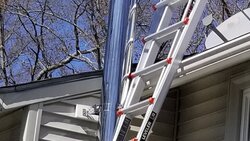I doubt the OP is on the thread anymore, but I'd think on the UP, you'd either have to move the pipe; or accept that you're asking for trouble, and go with serious, brute force (custom, very heavy duty armoring), for the reasons below:
Mr. GLO, If it were me, I'd try to find out what works and doesn't in your area. Around here, it's just a fact of life that anything that doesn't penetrate within a few feet of the peak is going to give a lot of trouble, even with a comp roof. Not knocking people's products, but nothing I've seen linked in the thread is up to the job for a down the roof pipe in serious snow areas. If it was, it would probably be too heavy and cumbersome to ship affordably.
The gradual mauling and mangling of folks summer cabins kind of helps mark the passage of the winter months here. So, maybe there's an idea for you in what I see. There's no code here, so it's build-what-you-feel-like, and folks do! I could take a half hour drive around and get 10 pictures of mid-slope pipes pushed down the roof by wedges (aka crickets) that were crushed into fins or ripped completely off, and probably just as many tieback supports that have been bent into a U pulling the stovepipe back toward the peak. Tiebacks that attach mid slope take the brunt of sliding snow, and those that run close to the peak are often long spans vulnerable to damage when the snow slides out from under them pulling down on the middle of the long span.
You've the worst situation by being at the bottom of the roof. I know of large masonry chimneys that have been pushed over from being in that location, when the wedge failed.
You could make or have made a wedge made that would not crush - maybe 1/4" aluminum with a lot of interior bracing. Then you have to anchor it to the roof structure with equivalent seriousness. The wedge needs to be as wide as the pipe, for as far up as sliding snow will be able to reach on the wedge. I see that mistake a lot. It the snow gets ahold of the pipe a few feet above the roof, it gets a lot of leverage on the pipe that way.
One big thing to think about, is a wedge isn't a wedge if the snow can't be wedged away for some reason. Standing seam is going to seriously impede wedging (and might also get damaged in the effort), as will a nearby valley or other obstruction. And, sometimes the snow just gets to a consistency where it refuses to be wedged. If there's a layer of compacted snow or ice on the bottom engaged with the roofing, that slab of snow is like a slab of concrete, set on rails. If the wedge can't wedge, it becomes a brake, which is not a bad thing, as long as it's up the huge forces that will be exerted on it, and the roof is ok holding the weight of the snow that isn't sliding off.
You might consider more of a brake, than a wedge, if you have standing seam, and not tons of snow. Something stout as hell, as tall as the snow that accumulates, and angled just slightly to the sides to promote water drainage. The idea being just to keep the snow there and away from your chimney until spring. Downside - you'd probably get big icicles at some point from this. I've seen little success here with the shorter 3-4" snow brakes used along the slope of the roof. The snow is like a glacier, and always moving slowly down despite the little brakes. They might help though, if your snow doesn't last long enough, or your roof isn't steep enough, for it to move substantially.
If 2 feet of snow is a lot for you, then a lot less than the measures we have to go to, would be appropriate. Again, I think it comes down to seeing what others are getting by with in your area, factoring in how much roof you have uphill of what you want to protect, unless you just want to build bomb-proof (nothing wrong with that, either, one and done is always nice).



